The Internet of Things (IoT) is transforming the poultry sector by optimizing environmental monitoring, improving animal health, managing resources efficiently and ensuring product traceability. This technology drives sustainability and reduces environmental impact, improving operational efficiency and animal welfare in the sector.
- The Internet of Things (IoT) has emerged as one of today’s most revolutionary technologies, transforming sectors as varied as health, agriculture, manufacturing and, of course, the poultry sector.
This technology, which is based on the interconnection of devices via the Internet, is changing the way companies operate, manage their resources and make strategic decisions. In the case of poultry farming, IoT is improving efficiency, sustainability and animal welfare in ways that previously seemed unimaginable.
WHAT IS THE INTERNET OF THINGS (IOT)?
The Internet of Things (IoT) refers to the network of physical objects that are connected to the Internet and can exchange data with each other and with other systems. These devices range from temperature, humidity and movement sensors to security cameras, all designed to collect data in real time and facilitate decision-making.
- In the poultry sector, these devices have applications ranging from environmental monitoring to tracking bird behavior.
IMPROVING MONITORING OF THE POULTRY ENVIRONMENT
One of the main challenges in poultry farming is maintaining a suitable environment for the growth and health of the birds. Factors such as temperature, humidity, ventilation and air quality are crucial to ensuring optimal development.
IoT devices enable constant monitoring of these conditions, automatically adjusting heating, ventilation and cooling (HVAC) systems based on the data received from the sensors.
- This not only ensures that the birds are in an ideal environment, but also reduces energy consumption and operating costs.
ANIMAL HEALTH AND WELFARE WITH IOT
Poultry health is another key aspect for the success of the poultry sector. IoT technologies enable real-time monitoring of bird behavior, such as activity levels, feed and water consumption and even body temperature.
Sensors placed in the facilities or on the animals themselves can detect early signs of disease, stress or behavioral problems, allowing for quick and effective intervention.
- This not only improves animal welfare, but also helps prevent disease outbreaks that could affect production and food safety.
OPTIMIZING FOOD AND WATER MANAGEMENT
IoT is also transforming the way basic resources such as feed and water are managed in the poultry sector. With the use of smart sensors, systems can monitor the consumption of these substances, automatically adjusting the quantities distributed to the birds according to their individual and group needs.
- IoT is also transforming the way basic resources such as feed and water are managed in the poultry sector. With the use of smart sensors, systems can monitor the consumption of these substances, automatically adjusting the quantities distributed to the birds according to their individual and group needs.
TRACEABILITY AND QUALITY CONTROL
Traceability is an essential aspect in the food sector. Consumers are increasingly interested in knowing the origin of the products they consume, including poultry meat. With IoT, data on every stage of the production process, from hatching to distribution, can be collected and stored in real time.
- This facilitates the creation of an efficient traceability system, which not only improves transparency and consumer confidence, but also allows producers to quickly detect possible quality or food safety problems.
REDUCING ENVIRONMENTAL IMPACT
Sustainability is a growing concern in the poultry sector, both in terms of waste reduction and environmental impact. IoT systems can help farms optimize the use of energy, water and resources, reducing waste and minimizing the impact of poultry farming on the environment.
- In addition, precise control of facility conditions allows for greater efficiency in the management of organic waste, such as poultry droppings, which can be used as fertilizer or biogas.
CHALLENGES AND CONSIDERATIONS
Despite the indisputable benefits of IoT in the poultry sector, there are also challenges. One of the main ones is the initial investment in technology, which can be considerable for small and medium-sized poultry farms. In addition, managing and analyzing large volumes of data generated by IoT devices requires adequate infrastructure and trained personnel.
- Another challenge is cyber security, as the interconnection of devices increases the risk of cyber attacks that could compromise control systems and confidential data.
CONCLUSION
The Internet of Things has proven to be a powerful tool for improving efficiency, sustainability and animal welfare in the poultry sector. From environmental monitoring to health management and product traceability, IoT is enabling poultry producers to make more informed decisions and optimize their processes.
- As technology continues to advance, IoT adoption is likely to continue to grow, leading the poultry sector into a more efficient, safe and environmentally friendly future.
We invite you to participate in Latin America’s poultry and animal nutrition industry event, the LPN Congress, which will cover in-depth up-to-date topics that will be taught by renowned experts from both a theoretical and practical point of view. The unmissable event will be held from October 7 to 9, 2025 in Miami, USA.


